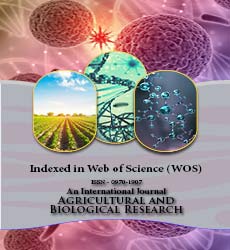Agricultural and Biological Research
RNI # 24/103/2012-R1
Temesgen Tafesse, Rael Desalegn, Chimdesa Tolera, Ayantu Nugusa and Desalegn Amenu*
Background: In regions like Nekemte, located in the East Wollega Zone of Western Ethiopia, honey production is not only a traditional practice but also a source of livelihood for many communities. Understanding the physicochemical attributes and biological activities of honey from this region is essential for assessing its quality, safety and potential health benefits. This study evaluated the physicochemical characteristics and antibacterial activities of honey sold at Nekemte, East Wollega Zone.
Materials and methods: Honey samples were collected from various vendors in Nekemte and analyzed for their physicochemical characteristics, including moisture content, pH, total acidity, color and sugar composition. The antibacterial activity of the honey samples was assessed using agar well diffusion and broth micro dilution methods against selected bacterial strains.
Results: Antimicrobial activity of honey tested against five bacteria: S. aureus, E. coli, S. typhimurium, S. flexneri and P. aeruginosa. The results showed that the honey had a pH and EC value of 3.5 to 3.96 and 0.48 m/Scm to 1.17 m/Scm, respectively. Honey has been known to possess antimicrobial properties and wound healing activity. The total sugar and ash contents varied from 65 g/100 g to 83.00 g/100 g and 0.28 g/100 g to 0.75 g/100 g. The antibacterial activity assay was conducted at concentrations of 100%, 75% and 50%. Jemoa honey showed more antibacterial effects at 100%, while at 75%, all pathogens had fewer effects below 10 mm. At 50%, all strains were found to be resistant.
Conclusion: Overall, the study demonstrated that Ebantu (Qello) honey exhibited significant antibacterial properties against common pathogens, particularly at higher concentrations. These findings support the potential use of honey as a natural antimicrobial agent in wound care and infection control.
